 |
| Brando in The Wild One, 1953. Photograph: Michael Ochs |
More than a contender: Marlon Brando’s greatest performances – ranked!
Lovers, fighters … and gangsters? On the centenary of the actor’s birth, we pick out his greatest roles
20. A Countess from Hong Kong (1967)
A minor picture with curiosity value: Charlie Chaplin’s final film as a director, starring Brando and Sophia Loren, a comedy in the style of the Hollywood Golden Age, based on the tall tales of a real-life Russian singer and in fact originally conceived by Chaplin in the 30s for Paulette Goddard. Brando plays an American diplomat who is astonished to find that the Russian countess (Loren) he was charmed by in Hong Kong has stowed away in his cabin on the voyage home. Brando does his best and this method legend was sufficiently in awe of Chaplin to submit to his old-fashioned way of working: acting out for Brando the required line-readings and movements. (Oh, to have had fly-on-the-wall location footage of these moments.) Certainly, Brando would never again be so submissive with a director.
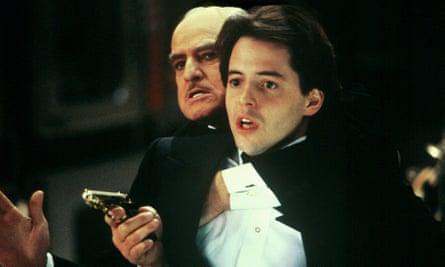
19. The Freshman (1990)
As The Godfather becomes ever more important in film history, so there may be a kind of gathering tacit consensus among cinephiles that this should be tactfully overlooked or just forgotten about: a film in which Brando risked devaluing his brand by actually spoofing the Vito Corleone persona. He plays shady New York businessman Carmine Sabatini, who astounds fresh-faced film student Matthew Broderick with his resemblance to the legendary Don Corleone, with Brando doing all the wheezing, grandfatherly, adenoidal mannerisms. Sabatini gives Broderick’s character a job as a delivery boy, which may be a subtle reference to Apocalypse Now. A sprightly, watchable movie.
18. Mutiny on the Bounty (1962)
This Technicolor seafaring spectacular had Brando aboard the HMS Bounty playing high-minded naval officer Fletcher Christian, who will no longer tolerate the arrogance and cruelty of Captain William Bligh, a role fiercely and theatrically dispatched by Trevor Howard. It is an intriguing faceoff, and a big Hollywood stage for Brando to grandstand. It is always interesting to hear Brando doing a stagey Britspeak accent, but this is a clenched and formal role for him.
17. Viva Zapata! (1952)
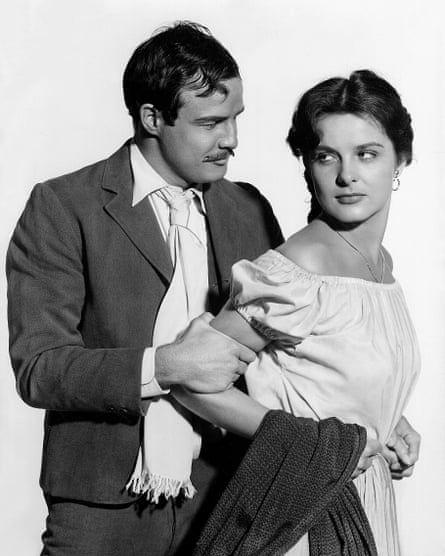
With Eli Kazan directing, John Steinbeck writing and Brando in the lead role, the ingredients should surely have been in place for something great, yet the film about the great Mexican revolutionary leader Emiliano Zapata falls a little short of that. It is something to do with the dodgy blackface Mexican makeup and the droopy moustache, which was considered unconvincing at the time and more objectionable as the years have gone by, especially as Brando was always such an outspoken campaigner for civil rights and anti-racism. Brando’s Zapata begins the action as a simple, wide-eyed peasant and quickly becomes a natural leader: the role showcases Brando’s gift for hauteur and rebellious contempt for authority.
16. The Missouri Breaks (1976)
Moviegoers were longing for a Marlon Brando/Jack Nicholson pairing; they finally got it in this revisionist 70s western from director Arthur Penn. If the result wasn’t quite the combustible mix they were expecting, perhaps it’s because there’s only room for one smouldering legend on screen at once, and Nicholson was reportedly intimidated by Brando. Nicholson is Tom Logan, a cattle rustler, and Brando is the coolly intimidating “regulator” or mercenary bandit, hired by a land baron to drive away rustlers or kill them. Perhaps the role itself meant that Brando was going to steal the scene, especially with his juicy Irish accent. But the movie doesn’t come properly to life.

15. The Men (1950)
Brando’s screen debut was in this robustly made, heartfelt and well-meant issue movie from screenwriter Carl Foreman and director Fred Zinnemann. Brando plays a US soldier severely injured in the second world war and confined to using a wheelchair, coming to terms with his situation in the Veterans Administration hospital and having painful scenes with his fiancee who is now frightened of him; he suspects she now wants out of the marriage and perhaps, in his angry and confused heart, he can’t blame her. The pure nobility and handsomeness of Brando’s face and head was perhaps never more clearly showcased than in this early picture, and it shows us a distinct part of Brando’s screen acting style; that sense of bottled-up anger against some restriction or injustice that he can’t or won’t clearly describe.
14. Burn! (1969)
A complicated, richly detailed role for Brando, directed by Gillo Pontecorvo (immediately after his Battle of Algiers) and a film to set alongside Viva Zapata! or Mutiny on the Bounty – only this time Brando is on the side of the rebels in the most duplicitous way. He plays Sir William Walker, a British adventurer and mercenary (in fact based on an American historical figure), tasked by the 19th-century British government with fomenting a slave uprising in a Portuguese colony in the Caribbean so that the resulting indigenous government will be a puppet state run by British commercial interests. Brando’s Walker is arrogant, cynical, worldly and cunning – another example of Brando’s stagey but serviceable British accent transforming his whole being from lithe American into haughty and very English-patrician-looking performer.
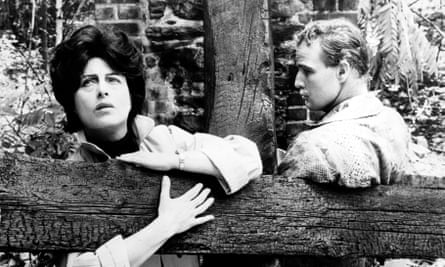
13. The Fugitive Kind (1960)
Brando’s association with Tennessee Williams in A Streetcar Named Desire has become legendary and it confers some interest in Brando’s later Williams film, in which he plays a familiar role in a steamy drama directed by Sidney Lumet, co-written by Williams adapting his play Orpheus Descending. Brando is the sexy, earthy, guitar-playing drifter Snakeskin who blows into a small town, evidently wanted by the cops back in New Orleans. Many of the drunk or bored women around the place are interested in Snakeskin, but he seems to have feelings for the unhappily married woman running the local store, played by no less a movie figure than Anna Magnani. She is someone he can open up to about his feelings and his inner life, and in this movie we see the plaintive, almost martyred Brando expression, his eyes repeatedly turned upwards as he speaks like a secular saint.
12. Sayonara (1957)
Self-conscious it may be, but this handsomely produced romantic drama of the postwar years, based on the chunky bestseller by James A Michener, deals earnestly and forthrightly with the subject of racism. Brando’s fighter pilot Ace, based in Japan, starts out with the usual bigoted attitudes, and entirely in agreement with the US army’s rules against interracial relationships. But then he falls deeply in love with elegant Japanese singer Hana-ogi, played by Japanese-American performer Miiko Taka. Today, the movie might be vulnerable to charges of orientalism and exoticism, but ittoughly sticks to its conviction that the union of a white American man and a Japanese woman can and will work out. The title means saying “goodbye” to racist attitudes.
11. Superman (1978) + Superman II: The Richard Donner Cut (2006)
Brando got a huge fee for a small cameo in the 1978 Superman movie starring Christopher Reeve, which laid the groundwork for superhero movies becoming the westerns of the 21st century – and perhaps also laid the groundwork for Brando’s own cynical and rather boorish disenchantment with movie-making generally. Certainly Reeve made no secret of his dismay and disillusion at Brando’s shrugging and negligent attitude. Brando played Superman’s snowy-haired father Jor-El on the doomed planet Krypton in both the first film and the sequel as directed by Richard Donner, but when Donner was fired from Superman II, which was almost entirely reshot by replacement Richard Lester, Brando’s excised contribution only surfaced when the Donner cut was released in 2006. Perhaps Brando would have raised his game if he had been cast as Lex Luthor, the part that went to Gene Hackman.
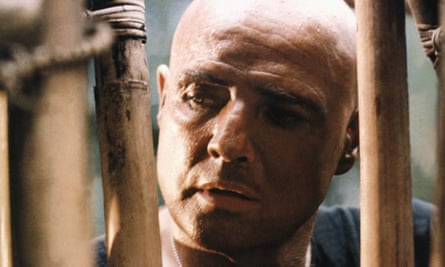
10. Apocalypse Now (1979)
This is the great Brando icon-cameo, the movie in which his small, incomparably potent contribution makes sense because of the fugitive legend nature of the part –rather like Orson Welles in The Third Man. He plays Col Kurtz, the brilliant and once exemplary US army officer who must be tracked down during the Vietnam war, having gone mad in the Cambodian jungle and established his own cult where he is worshipped as a pagan god. Brando’s head looms out of the darkness like an angry planet or a giant carved fetish; just his face, and those staring eyes, are enough to compel (and scare) the viewer. His scenes above ground, which surfaced with the newer director’s cuts successively licensed by Francis Ford Coppola, are, in their way, just as unsettling, and the breathy, semi-strangulated Brando voice is like a sinister message from the bowels of the earth.
9. The Chase (1966)
Brando got the above-the-title billing that might more properly belong to the young Robert Redford, who played the criminal who has just escaped from a Texas prison and is being chased by Brando’s sheriff. The latter is hoping to catch Redford’s desperado before he discovers his wife (Jane Fonda) is having an affair with the town’s wealthy businessman, who has the lawmen in his pocket. Brando has the smaller role and is, at this stage of his career, heavier set and slower moving, beginning to concede the star roles to a younger generation. But he still has that power and sleekness to his bearing.
8. Last Tango in Paris (1972)
No film of Brando’s has become discredited more than this drama of death, grief and obsessive sex. Brando is stricken widower Paul, whose wife might have taken her own life (or been driven to it by Paul); he tries to cauterise his spiritual agony with regular, brutally anonymous and explicit sex with hippy-chick Jeanne, played by Maria Schneider. Her air of vulnerability is very disquieting since the revelation in 2013 that Brando and director Bernardo Bertolucci planned the improvised “butter” scene without telling Schneider and she therefore felt in effect raped. Perhaps there is no way of seeing past this, but Brando’s performance has that ruined leonine hauteur, a vast disgust and self-disgust – and there is inspiration in his final Cagneyesque top-of-the-world moment in Maria’s apartment in which he does his florid Briton accent. This is a movie experience about nausea; more nausea than its creators realised.

7. Julius Caesar (1953)
Mark Antony was a part that Brando was born to play: his extraordinary profile could appear on a Roman coin or statue. It was a film reportedly inspired by the success of Olivier’s Henry V and here, fascinatingly, Brando portrays the role with the absolute assurance and distinction of someone who has had classical training, a great relief to those who worried that he could only perform in mumbling method-speak. How fascinating would it have been to see Brando play Coriolanus, or Leontes, or Lear; he might well have been the American Olivier, although here I have to say that his English-Bardspeak accent is in misplaced good taste. (And maybe The Godfather was his Shakespearean career-climax.) Director Joseph L Mankiewicz and producer John Houseman should have encouraged him to speak in his normal American accent.
6. The Wild One (1953)
A decade before the counterculture got into full swing, this outlaw biker movie – in effect banned in the UK until 1967 – gave us a hint of the forthcoming speed-thrills of rebellion, starring Brando as leather-clad Johnny, leader of the Black Rebels Motorcycle Club. (In fact, motorbike lawlessness had been in evidence in the US since the end of the war.) “Hey Johnny, what are you rebelling against?” a young woman asks. “What’ve you got?” Brando famously replies – incidentally reviving the memory of Groucho Marx’s song I’m Against It in Horse Feathers. Johnny is against the older generation, against the idea of marriage and getting a job, against everything and nothing. Brando’s sheer physical heft and presence lend a kind of meaning and purpose to his outlaw vocation.
5. One-Eyed Jacks (1961)
This stark and mesmeric revenge western, co-written by Sam Peckinpah, which Brando co-produced and wound up directing himself, is his sole directing credit, having originally hired Stanley Kubrick. He plays Rio, the bank robber who works with (older) partner, “Dad” Longworth, played by Karl Malden. After one lucrative job in Mexico, the two-faced Dad leaves Rio to be captured by the cops and Rio does five years in prison. On release, Rio fanatically tracks Dad down to discover his former comrade has now reinvented himself as a respectable lawman and sheriff; things are complicated further when Rio falls for Dad’s stepdaughter Louisa (Pina Pellicer). There is something Freudian in his conflicted need to kill, or not kill, “Dad”.
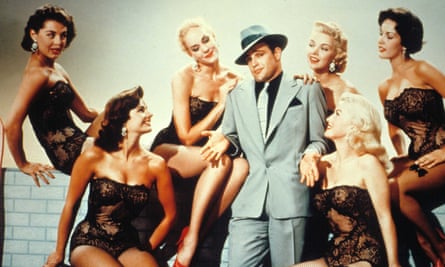
4. Guys and Dolls (1955)
Brando was never thought of as a musical star before or after Guys and Dolls, which feels like an outlier – and yet Brando gives a glorious performance as inveterate gambler and romantic Sky Masterson who falls in love with Jean Simmons’s Salvation Army stalwart Sarah Brown. Brando sings his own numbers without dubbing and his version of Luck Be a Lady, although clearly not the work of a Broadway pro, is still an absolute showstopper. Brando reportedly had a chilly on-set relationship with Frank Sinatra, who played Nathan Detroit – something that continued to rankle with Sinatra when he saw the Johnny Fontaine character in The Godfather 17 years later, and realised who it was supposed to be.
3. A Streetcar Named Desire (1951)
Kazan was a passionate, intuitive director of actors and Brando did some of his very best work for him – and in Tennessee Williams’s famous drama Brando truly detonates his sexuality and rage. He plays Stanley, the sullen, moody, swaggering and often shirtless husband of Kim Hunter’s Stella living in a tough part of New Orleans. Stella’s highly strung, refined sister Blanche (played by Vivien Leigh ) comes to stay, and from the very first, she ignites a deeply ambiguous mix of desire, wariness and class-based resentment in Stanley. It is a toxic chemistry. Does Stanley want to go to bed with her? Does he want to punish Blanche for apparently squandering her parents’ money to which, as brother-in-law, he considers himself partly entitled? Is Blanche a projection of Williams himself, tauntingly seeing and provoking the mixed-up feelings in so many young men? Brando instinctively and sensually embodies all of this; it is a role that unlocked so much of his acting genius.
2. On the Waterfront (1954)
This was the movie that most fully allowed Brando to be a tragic hero and a figure who directly engages with contemporary America. In a tale ripped from the headlines, he is Terry Molloy, an ex-boxer turned dockyard worker, demeaningly running errands for the corrupt union mob boss and beginning to go to seed, nursing a muddled and self-destructive rage. He could have been a contender, but his brother Charley (Rod Steiger) persuaded him to throw a key fight to enrich this same mob boss and his career was never the same again. Now Terry is convulsed with shame for having connived at the murder of a longshoreman who was going to testify about corrupt practices, and he falls in love with the dead man’s sister, played by Eva Marie Saint. Brando conveyed all the inarticulate pain, aimless uncertainty and dissatisfaction with the world; he is a tough guy with a gallant streak and the soul of a poet.
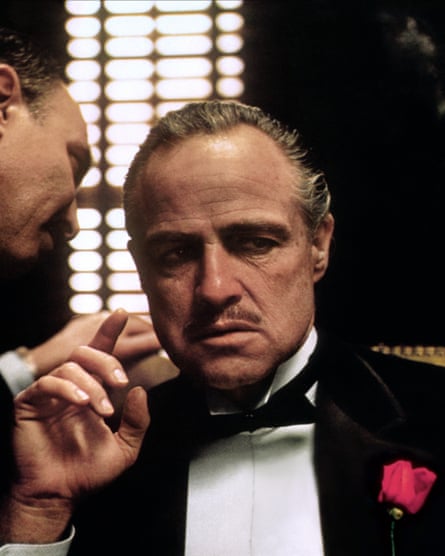
1. The Godfather (1972)
Apart from everything else, Brando’s sensational starring role in Francis Ford Coppola’s Shakespearean mob drama was an amazing comeback. Just when everyone thought that Brando was on the slide, he returned suddenly as an obviously older man, but with a power and reach even greater than that of the lithe and potent performances of his youth. All of his mannerisms, the faintly adenoidal speaking voice, the muscular assertion, the almost ethereally inarticulate expression of pain; they had now a new maturity and poignancy. His Vito Corleone, presiding over a powerful crime family in postwar America, is fearful of losing his power, and unsure which of the younger generation will carry on the flame. His presence at the wedding scene, receiving petitioners in his darkened study surrounded by consiglieri, is unforgettable, as his later speech, telling the other capi at the peace summit what he will and will not forgive even as his own authority is ebbing away. This was Brando’s claim to movie immortality.

No comments:
Post a Comment